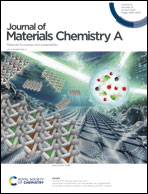Leveraging the Cu2SnTe3 additive for an improved thermoelectric figure of merit and module efficiency in Bi0.5Sb1.5Te3-based composites†
Abstract
As a benchmark for commercial room-temperature thermoelectric (TE) materials, the widespread demand for recovering distributed low-grade waste heat (below 573 K) underscores the immediate necessity for advanced Bi2Te3-based alloys. Here, we achieved a 22% enhancement of the peak ZT to 1.43 at 325 K by incorporating highly reactive additive Cu2SnTe3 into Bi0.5Sb1.5Te3, which is notably higher than that of most BixSb2−xTe3-based composites. This remarkable enhancement is facilitated by the in situ reaction of decomposition products with the matrix, thereby boosting hole concentration and the density-of-states effective mass, while experiencing little loss in hole mobility. Simultaneously, the lattice thermal conductivity is significantly reduced by multiscale scattering sources, typical of dislocation arrays and Sb and Cu-rich nanoprecipitates. These synergistic results yield a 30% enhancement of the TE quality factor at 300 K, reaching 0.52 for the optimal Bi0.5Sb1.5Te3 + 0.08 wt% Cu2SnTe3 sample. More significantly, when coupled with n-type zone-melted Bi2Te2.7Se0.3, the well-designed 17-pair TE module achieves a conversion efficiency of ∼6.0%, surpassing the majority of reported Bi2Te3-based modules, which further demonstrates the efficacy of the Cu2SnTe3 compositing strategy and the great potential for practical applications.

- This article is part of the themed collection: Journal of Materials Chemistry A HOT Papers


 Please wait while we load your content...
Please wait while we load your content...